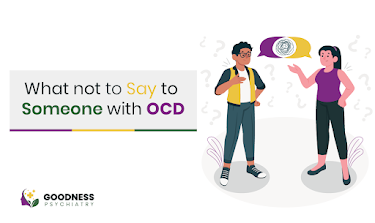How to Help Someone Who Is Dissociating – Goodness Psychiatry
Dissociation is a complex psychological experience that can be unsettling for both the person experiencing it and those around them. Understanding how to help someone who is dissociating is crucial for providing effective support. This blog will explore what dissociation is, how to recognize it, and practical steps you can take to help someone navigate through these challenging moments.
What Is
Dissociation?
Dissociation is a mental process used by individuals to cope
with stress or trauma. It involves a disconnection between a person's thoughts,
memory, and sense of identity. When someone is dissociating, they might feel
detached from their surroundings or themselves. This experience can vary
widely, from mild detachment to severe disorientation.
Dissociation can manifest in different ways. It might
involve a feeling of being disconnected from one's body or surroundings, having
trouble recalling important information, or experiencing a sense of unreality.
Understanding these symptoms is essential for recognizing when someone is
dissociating and for providing appropriate support.
What Does
Dissociation Look Like?
Dissociation can present itself in several forms. Here are
some common signs:
- Feeling
Detached: The person might seem distant, detached, or "spaced
out."
- Memory
Gaps: They may have trouble recalling recent events or details about
themselves.
- Out-of-Body
Experiences: Some individuals may describe feeling as though they are
observing themselves from outside their body.
- Altered
Perception: They might experience distorted perceptions of time,
space, or identity.
Recognizing these signs can help you identify when someone
is dissociating and determine the best course of action to support them.
How to
Help Someone Who Is Dissociating
Supporting someone who is dissociating requires patience,
understanding, and practical strategies. Here are some steps you can take to
help:
- Remain
Calm and Reassuring: Approach the situation calmly and offer
reassurance. Your calm demeanor can help reduce the person's anxiety and
prevent further disorientation.
- Use
Grounding Techniques: Grounding exercises are effective for helping
someone reconnect with the present moment. Techniques include:
- Sensory
Awareness: Encourage the person to focus on their senses. For
example, ask them to notice what they can see, hear, or touch.
- Deep
Breathing: Guide them through deep breathing exercises to help them
relax and ground themselves.
- Physical
Touch: If appropriate, a gentle touch or holding their hand can help
them feel more connected to reality.
- Encourage
Mindfulness: Mindfulness practices, such as focusing on the present
moment or engaging in simple, grounding tasks, can help the person
stabilize their sense of self.
- Create
a Safe Environment: Ensure the environment is calm and free of
overwhelming stimuli. A peaceful setting can help reduce the intensity of
dissociation.
- Be
Patient and Non-Judgmental: Understand that dissociation is a coping
mechanism, and avoid expressing frustration or judgment. Your support and
empathy are crucial.
- Suggest
Professional Help: If dissociation is frequent or severe, encourage
the person to seek professional help from a mental health provider.
Therapy can offer them effective tools and strategies to manage
dissociation.
Grounding Exercises for Dissociation
Grounding exercises are particularly helpful for managing
dissociation. They are designed to bring a person’s awareness back to the
present moment and can be a valuable tool in helping someone who is
dissociating. Here are some grounding techniques:
- Guide the person to identify 5 things
they can see, 4 things they can touch, 3 things they can hear, 2 things
they can smell, and 1 thing they can taste. This technique helps shift
focus away from dissociation and back to the immediate environment.
- Safe
Place Visualization: Encourage them to imagine a safe, calming place.
Ask them to describe this place in detail to help anchor them in a sense
of safety.
- Physical
Sensations: Have them focus on physical sensations, such as the
feeling of their feet on the ground or the texture of an object they are
holding.
- Movement:
Gentle movement, such as stretching or walking, can help some individuals
reorient themselves and reduce the effects of dissociation.
Conclusion
Understanding how to help someone who is dissociating
involves recognizing the signs of dissociation and using effective grounding
techniques to support them. By remaining calm, employing grounding exercises,
and encouraging professional help when needed, you can play a crucial role in
helping someone navigate through dissociation.
Remember, dissociation is a complex phenomenon, and while
your support is invaluable, professional guidance is often necessary for
long-term management and recovery. If you or someone you know is struggling
with dissociation, consider reaching out to a mental health professional for
further assistance.
For more information on how to support individuals
experiencing dissociation or other mental health challenges, visit Goodness Psychiatry.
.jpg)
.jpg)

Comments
Post a Comment